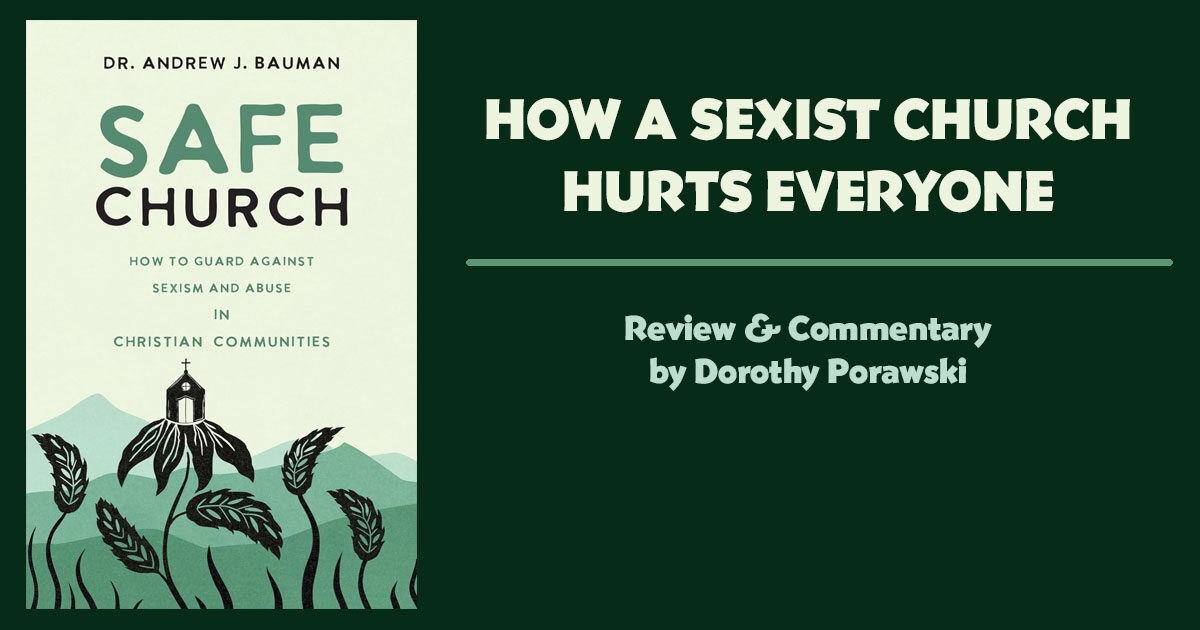A Sexist Church Hurts All of Us: Commentary on Safe Church by Andrew J. Bauman
28 February 2025 |
Safe Church: How to Guard Against Sexism and Abuse in Christian Communities. By Andrew J. Bauman, Baker Books, 2025, 192 pages. Reviewed by Dorothy Porawski
As a woman with her own personal church baggage, few topics get my blood pumping and my temperature rising like the systemic problems of abuse and sexism in the Christian church. Hardly a day passes without another scandal emerging from Protestant congregations involving pastors and church leaders harassing, abusing, and/or committing sexual assault against women.
Horrifically, and too often, not only do church leaders fail to react appropriately, but their strategies show how they are clueless about or simply uninterested in the underlying causes of this systemic problem.
In Safe Church: How to Guard Against Sexism and Abuse in Christian Communities Dr. Andrew J. Bauman examines these issues, offering practical solutions based on his experience as a pastor and clinical psychologist, and a three-year qualitative study of 2,800 women who encountered sexism and abuse in their churches while working as employees or volunteers.
I’ve freely incorporated Bauman’s research in making my own conclusions as I see them applied to the Seventh-day Adventist Church.
A denomination in denial
We Seventh-day Adventists, it seems to me, consider ourselves so reformed, so countercultural, and so unique that we needn’t acknowledge sexism and abuse as anything more than rare exceptions. Yet while we have broken away from mainstream Christianity over unique doctrines such as the seventh-day Sabbath and the investigative judgment, we have many of the same systemic issues regarding sexism that afflict other evangelical churches.
This is particularly ironic for a denomination that so highly upholds the authority and teachings of its 19th-century prophetess.
Like our conservative evangelical counterparts, the Seventh-day Adventist Church systematically underrepresents women. This is a red flag. Though women make up the majority of Adventist congregations, they hold only a fraction of pastoral and elder positions. Women are the minority in nominating committees, delegate councils, theology publications, media, and the pulpit. In other words, for all public and practical purposes, the church looks and sounds disproportionately male.
One of Bauman’s key points is the crucial necessity of empowering women, listening to them and encouraging them to share their experiences, stories, and perspectives. This is not only essential for healing the church and inspiring transformation towards safety, but also for understanding the fullness of God.
Men and women together reflect the image of God. When women are silenced, a part of God is silenced, and the church cannot fully encounter him.
Paralyzing the movement
Another red flag is how the Adventist Church has allowed patriarchal theologies, shaped by male-privileged hermeneutics, to creep into its teachings (see A Short History of the Headship Doctrine in the Seventh-day Adventist Church by Gerry Chudleigh). Once trailblazers of urgency in proclaiming the Second Coming, Seventh-day Adventists have allowed the zeal of our mission to stagnate.
I believe that complementarianism, the belief that women’s divinely assigned role is in the home while men are given leadership and authority, has greatly contributed to paralyzing our church. If we truly believed that Christ’s return was imminent, the church would resemble its pioneering days, when spreading the gospel took precedence over maintaining rigid gender roles, not to mention heated debates on ordination.
Instead, change is left to inertia, and only a few exceptions—a few North American union conferences now ordain women, and some Scandinavian unions have halted all ordination since 2015 to protest double standards—stand as evidence that true reform is possible.
Dangerous complementarianism
But what should shake us to our core more than this shift in priorities is the real danger these teachings pose to women. While some view the debate between complemintarianism and egalitarianism (equal worth and roles in the church, home, and society, without hierarchy based on gender) in gridlock, complimentarian teachings do more than define gender roles: they remove agency and create conditions that enable violence and abuse.
In his research Bauman found that more than 1 in 3 women in his study group reported experiencing some kind of sexual misconduct while serving in their ministry position. Studies from another source also show higher abuse rates in complementarian marriages than in egalitarian ones.
Bad exegesis
Mistranslations and male-privileged interpretations which turn texts such as the household codes of Ephesians 5 and 1 Corinthians 14:34-35 into universal mandates instead of time- and place-specific corrective statements have led women to believe that their worth lies in silence and submission rather than in full participation in the body of Christ according to their individual gifts and callings. The similar misuse of 1 Timothy 2:9-12,15 further dehumanizes women by weaponizing scripture to reinforce objectification, justify coercion, and prime for violence, limiting women’s ability to hold men accountable for their actions.
Men in the Seventh-day Adventist Church worldwide continue to hold the majority of decision-making positions. The highest administrative positions remain closed to women due to the issue of ordination. Under this model Jesus is not seen as a liberator and protector of women, the one who lifted women beyond the misogynistic constraints of the Greco-Roman society of his time. Jesus first revealed his messianic identity to a woman (John 4:26), allowed himself to be persuaded, and publicly recanted his original reluctance to act for a woman (Mark 7:29), and commissioned a woman as the first to proclaim his resurrection (John 20:17), among other examples.
The continued repression of women is not only harmful and conducive to violence but is also contrary to God’s character. Until the Seventh-day Adventist Church dismantles its patriarchal structures, it will not be as effective in resolving violence and the church will not be a truly safe place.
Men must lead
The burden of change does not rest on the shoulders of women, says Bauman. Men have been the main perpetrators of sexism and violence; they hold privilege and authority, and the responsibility to bring about change lies with them. They must take ownership of the harm they have inflicted and, without hesitation, tear down the toxic systems that perpetuate abuse.
Those men who understand the damage being done cannot quietly stand by, cheering women on and hoping that more leaders will eventually see the light. Men must be courageous advocates, willing to stand up to sexism when it happens and hold other men accountable.
Until the church is safe for women, it is not safe
While acknowledging that this process can be painful, Bauman stresses that if this transformation is to succeed it is crucial for women to speak, and for men to listen. Churches must become abuse-informed, and equip leaders with the tools to handle trauma and abuse responsibly. Practical steps include implementing rigorous abuse prevention training, ensuring leadership accountability, and creating safe spaces where women’s voices are heard and respected.
For Adventists specifically, this means questioning long-held assumptions about gender roles, examining how theology has been weaponized against women, and committing to real structural change. This may be the one time when it is really ok for Adventists to go back to their roots, to a time when we listened to a woman preacher, Ellen G. White.
If truth—present truth—is truly to be pursued then churches must be willing to confront these uncomfortable realities. Bauman provides everything necessary to set sincere followers of Christ on a path toward dismantling millennia of toxicity. Its message is both truthful and direct, with a call to action that cannot be ignored: until the church is safe for women, it is not safe at all.
Will the Seventh-day Adventist Church continue to uphold the status quo, or will it embrace the difficult work of justice, accountability, and change? Will it truly become the symbol of a city of refuge it claims to want to be?
A safe church is possible. I challenge the Seventh-day Adventist Church, as a global denomination, to lead the way in making it a reality.
 Dorothy Porawski is an American expat who has lived half of her life teaching English as a foreign language in Poland.
Dorothy Porawski is an American expat who has lived half of her life teaching English as a foreign language in Poland.




